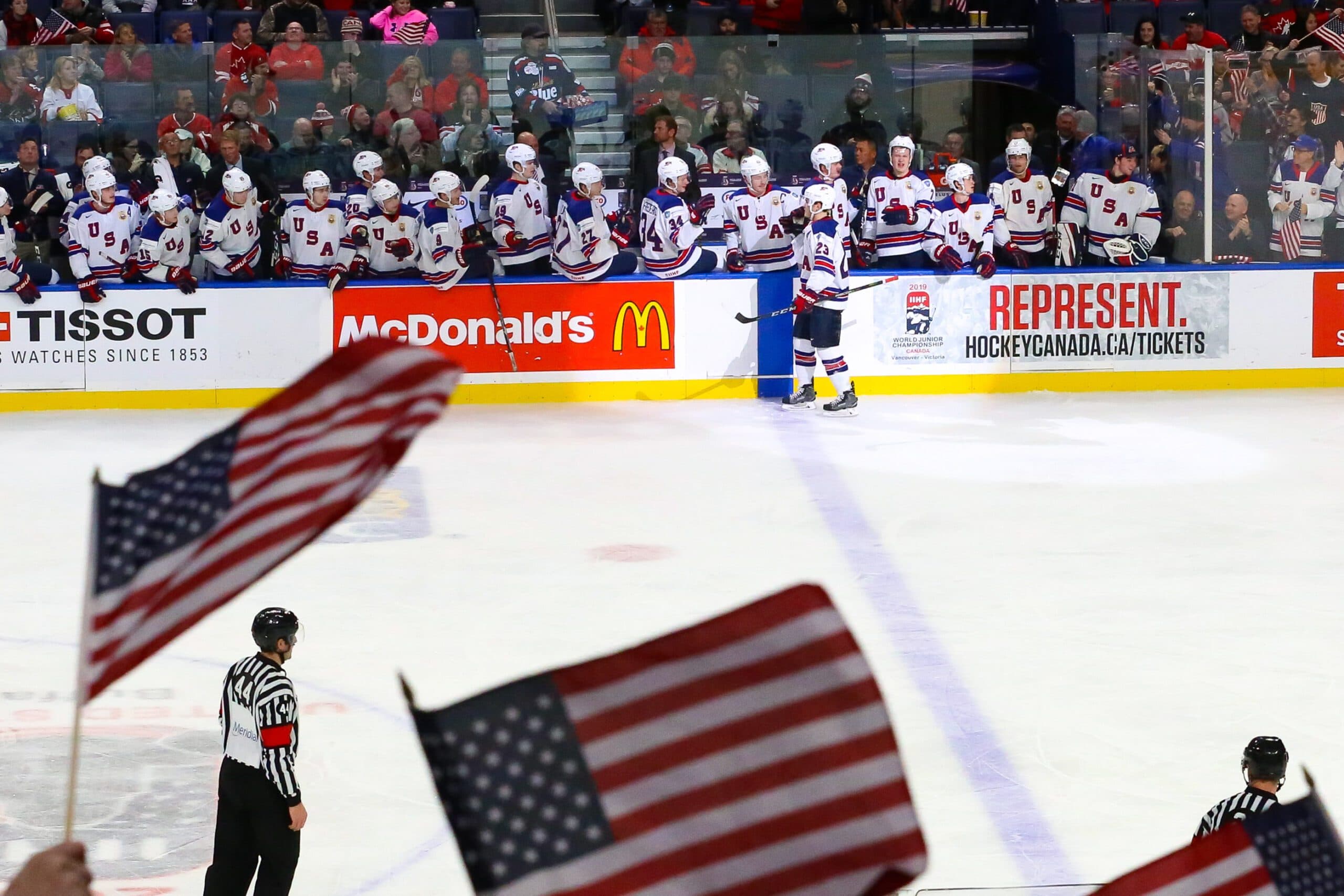Watch out, Canada: USA Hockey is coming for Olympic gold

O say can you see… what USA’s cooking up here?
When the NHL officially announced its return to the Olympics in 2026 – and the 4 Nations Face-Off as a precursor in 2025 – many started to draw up potential roster lineups for the next two years. For once, we actually seem to have a clear picture as to what’s next.
And one thing became crystal clear: the United States of America isn’t playing around. So much so that they might even go into the next two tournaments as favorites.
They’ve never had a more stacked offensive lineup. The defense corps is loaded with big names such as Quinn Hughes and Adam Fox. Canada can say a lot of the same things, with Connor McDavid, Sidney Crosby, Nathan MacKinnon and Cale Makar being among the best at their respective positions.
But the Americans have never felt that close – until now.
USA Hockey had a January to remember, winning gold at the World Juniors, U-18 women’s World Championship and the Youth Olympic Games. And that was after winning the World Para Ice Hockey Championship midway through December too. They’ve won six of the past nine major international tournaments they’ve participated in – including five of the past six IIHF events.
The team hasn’t figured out how to turn their junior hockey success into something tangible at the men’s World Championship level, with just one gold dating back to 1933 and no silvers since 1950. They’ve finally put themselves in contention to be a medal contender on a more consistent basis, but that loss in the third-place game to Latvia last spring stings.
But USA – like most other teams – never ices its highest-quality lineup at events like that. Yet with the NHL set to host the 4 Nations Face-off in 2025, and the return to the Olympics in 2026, we’re on the verge of seeing potentially the most dangerous lineups in the country’s history.
You can look to the recent NHL All-Star Game as a perfect example of America’s development success. They led all nations with 14 representatives – 15 if you count Jack Hughes, who was an assistant captain but didn’t play – to edge out Canada’s 13. Returning from the break, the top five goaltenders in save percentage among those with at least 20 games played were American.
There’s still room for USA to grow on draft day – their 50 players selected in 2023 were second to Canada’s 86 – but the USHL had a leading 39 players selected if you count the 13 from USA Hockey’s National Team Development Program. If you include USHL alum, that number rockets to 51 – marking the sixth consecutive draft in which the league produced at least 50. The USHL’s emergence as a true threat to the CHL – as well as the continued success of the USNTDP – has made it one of the premier development leagues in the sport.
As of 2023, the Americans are fourth in the men’s rankings and second in the women’s rankings. They’ve never been at the top of the men’s rankings and never better than fourth. But most of their international success comes at the junior levels that don’t contribute to the final rankings – and it’s all part of the bigger picture.
For so long, Canada was the team to beat in best-on-best competition. But that’s about to change. The Americans just need a chance to show it.
It starts with the USNTDP. For two years, some of the nation’s top junior-aged players compete against USHL and NCAA teams, with the highlight being the U-18 World Championship each spring. Some of the NHL’s top players – Auston Matthews, Jack and Quinn Hughes, Matthew Tkachuk, Patrick Kane, Jack Eichel, Clayton Keller and Phil Kessel are among notable graduates of the program. Soon enough, Will Smith, Gabe Perreault, Ryan Leonard, Cole Eiserman and James Hagens will become top-end NHLers.
“All the best U.S. guys play there, and they teach you at 16, 17 years old how to play in the NHL and get adapted to the schedule,” Anaheim Ducks forward Frank Vatrano said. “So I credit (the rise) to the NTDP, they do a great job.”
“Having a great program helps,” Jack Hughes said. “The game’s being played in different areas, but we become really close with really good players (at the USNTDP).”
The concept of centralizing – having a program that plays together consistently – isn’t new. It’s been tried in Slovakia, Latvia, Belarus and various other places, to varying levels of success. Sweden, Finland and Czechia will play in as many as four tournaments a year all the way from the U-16 to U-20 level.
But USA’s success at the World Juniors, U-18s and everything in between has proven this model can be so effective.
“You’ll see a lot of those guys come together in tournaments. The play in the U-18s, the U-20s – after they’re done with the program – so that helps create the bond right away, and you see the success in other tournaments,” Jets forward Kyle Connor said.
But it has to go beyond that – well beyond that. USA Hockey hosts Try Hockey for Free days every November and February, aiming to get more kids into the sport. There are also more high-performance hockey programs in more states. After a couple of difficult years impacted by COVID-19, USA Hockey had more than 646,000 members between players, coaches, and officials in 2022-23 – a step up from the 630,000-plus members the previous season. The organization is expecting an even bigger rise this year, and winning on the national stage at various levels only helps.
“Just speaking for myself, in youth hockey, Canadians always thought they were the best,” Vatrano said. “We’d go to tournaments, and there’d only be a few American teams. Everyone would talk about how great the Canadian teams were. Sometimes, the teams from the States would surprise others when we got there. So it’s nice to shove it in their face a little bit – but not too much, because they have a lot more on us than we have on them.”
And while Gary Bettman gets criticism for the NHL’s intense push for expansion during the 1990s – and again in recent years – putting the game in more markets has helped expand the game’s reach – even in places like Arizona, where Arizona State has become one of the fastest-growing college programs in the 64-school NCAA Division I slate.
“I think the league has done a really good job of expanding to markets that haven’t really experienced hockey,” said Ottawa Senators captain Brady Tkachuk. “You’ve got Arizona. You’ve got California, players coming from those places, Florida. Players who play for that team who love that city and stay there and implement their love for the game for kids in that area — just like St. Louis.
“You saw in that 2016 draft where five guys went in the first round. It shows that some of those markets are creating high-end talent like Auston Matthews in Arizona. I think we’re riding that wave and it’s just going to keep getting better in the U.S.”
Winnipeg Jets goaltender Connor Hellebuyck hails from Michigan, so he’s no stranger to big-market hockey. But he also played in Odessa, Texas, which isn’t exactly a hockey hotbed. He’s teammates with Neal Pionk from Omaha, Mason Appleton from Wisconsin, and Adam Lowry from Missouri – all of whom have strong development programs at various levels.
“You see a lot of States really embracing hockey, plus the NHL is all over the United States, which helps grow the game,” Hellebuyck said. “There’s a lot of people doing a lot of good things to help grow the game. There’s also a much bigger population to draw from, which helps.”
Next up? The 4 Nations Face-Off. It’ll be the first time the Americans will have gotten to play best-on-best hockey in nearly a decade, and the program has improved significantly in that time. They’ve got an abundance of young talent ready to play in multiple Olympic games. They’ve also seemingly become a goalie factory, with Dustin Wolf, Trey Augustine, Jacob Fowler and Drew Commesso waiting for their chance to shine.
The Americans haven’t proven anything yet…on the men’s senior side. The women’s team continuously racks up medals in every event they participate in, which will not change in 2026. But the men’s team has only won gold three times in major international competition, and never when any of their current roster candidates were ever alive unless you count the 1996 World Cup.
But do you want to bet against a team with their depth?
Potential 2025 USA Roster
Kyle Connor – Auston Matthews – Alex DeBrincat
Matthew Tkachuk – Jack Hughes – Brady Tkachuk
Jason Robertson – J.T. Miller – Brock Boeser
Tage Thompson – Jack Eichel – Clayton Keller
Jake Guentzel
Adam Fox – Quinn Hughes
Jaccob Slavin – Brock Faber
Jake Sanderson – Charlie McAvoy
Luke Hughes
Connor Hellebuyck
Thatcher Demko
Jake Oettinger

Discover Betano.ca – a premium Sports Betting and Online Casino experience. Offering numerous unique and dynamic betting options along with diverse digital and live casino games, Betano is where The Game Starts Now. 19+. Please play responsibly.
Recently by Steven Ellis
- 2024 NHL Trade Deadline: Ranking the top five seller teams
- Frank Vatrano wants to be a big part of the Anaheim Ducks’ resurgence
- NHL Prospect Roundup: Columbus Blue Jackets’ David Jiricek is too good for the AHL
- 2024 NHL Trade Deadline: 10 prospects who could be on the move
- For once, NHL All-Star Weekend was what it needed to be: Fun
- NHL’s return to the Olympics could be the start of a big era for the sport of hockey
- Top five NHLers to be traded for future considerations
- The five best value signings from the NHL’s 2023 UFA class
- 2024 NHL Draft Rankings: Midseason top 50
- What’s the deal with Cole Eiserman’s fall down 2024 NHL Draft rankings?
- Will Ilya Samsonov finally turn things around with Toronto Maple Leafs?
- Red-hot Ukko-Pekka Luukkonen is keeping the Buffalo Sabres in the playoff hunt
- 2024 NHL Draft: Eiserman, Hutson among top standouts from All-American Game
- Top five prospects dealt at the NHL Trade Deadline in the past 10 years